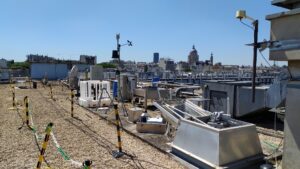A successful launch for the EarthCare satellite
Tuesday 28 May, 2024. ESA’s EarthCARE mission has successfully lifted off aboard a SpaceX Falcon 9 launcher from the Vandenberg military base in California.
Developed in cooperation between ESA and the Japan Aerospace Exploration Agency (JAXA), EarthCARE is the largest of ESA’s Earth Explorer satellites to date. It will take a range of measurements that will shed new light on the role that clouds and aerosols play in regulating the Earth’s temperature. Clouds and, to a lesser extent, aerosols reflect incoming solar energy back into space, but they also trap outgoing infrared energy.
The result is a net cooling or warming effect. Aerosols also influence the life cycle and composition of clouds and therefore contribute indirectly to their radiative effect, making the role of clouds in the climate system even more complex. So, although we know that clouds and aerosols play a decisive role in global warming, they remain one of the greatest uncertainties in our understanding of how the atmosphere governs the climate system.
EarthCARE will use a high spectral resolution lidar, a Doppler cloud radar, a visible imager and a broadband radiometer. These high-performance instruments have never been used in space before. The aim is to provide unprecedented data sets to enable scientists to study the relationship between clouds, aerosols and radiation at levels of precision that will significantly improve our understanding of these highly variable parameters.
EarthCARE instruments
- The satellite’s cloud profiling radar provides information on the vertical structure, movement and internal dynamics of clouds.
- The atmospheric lidar provides information on cloud tops and profiles of fine clouds and aerosols.
- The multispectral imager provides an overview of the atmosphere in several wavelengths.
- The broadband radiometer directly measures reflected solar radiation and outgoing infrared radiation.
These instruments and EarthCARE’s cutting-edge technology provide essential data for improving the accuracy of climate models and numerical weather forecasting.
IPSL and EarthCARE
In collaboration with their European colleagues and ESA, scientists from the IPSL laboratories have been working on this space mission from its definition to the present day. The mission consists of a high spectral resolution lidar, a Doppler cloud radar, a visible imager and a broadband radiometer.
Initially, Robert Kandel (LMD) defined the radiation balance component of the mission, Jacques Pelon (LATMOS), Pierre H. Flamant (LMD) and Gérard Mégie (LATMOS) its lidar component.
Martial Haeffelin (IPSL) then Hélène Chepfer (LMD) and Julien Delanoe (LATMOS) worked within the NASA/JAXA Mission Advisory Group to prepare the scientific exploitation of the EarthCare mission in line with the A-train missions (Calipso, CloudSat, CERES, MODIS).
Pour en savoir plus
ESA Agency
JAXA Agency
EarthCARE – ESA’s cloud and aerosol mission
Sources : CNRS Terre & Univers. ESA.
Video
The launch press review (Marjolaine Chiriaco)
https://eeclat.ipsl.fr/2024/05/29/lancement-dearth-care-revue-de-presse/






